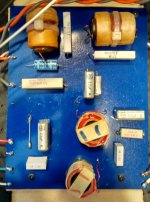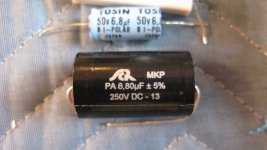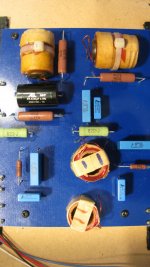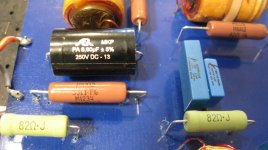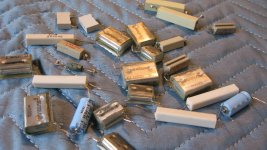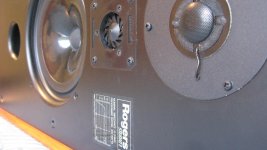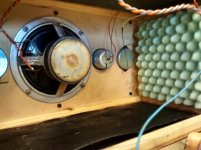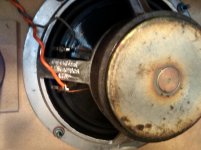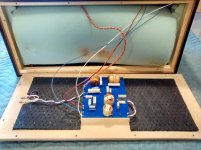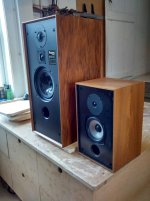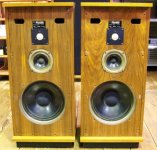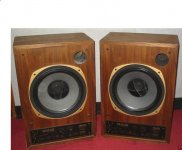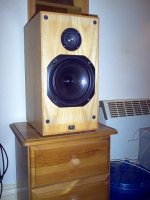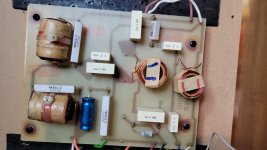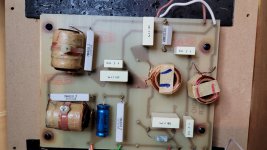Brought a pair of Rogers Studio 1 they were in fantastic shape cosmetically everything on the outside looked good as new...
When removed the backers to have a look inside found that one of the cross-over boards had been played with some of the resistors were missing and or bypassed. [One owner but he had passed away so no asking him]
They sounded Ok the one with the missing resistors sounded better to me...
The other had been played with but the parts were all there just not original.
So decided to replace the boards so both were the same as intended from the designer.
Sourced parts from Germany and Canada.
Audyn MKT radial / SCR audio capacitors and Mills and Kiwame resistors.
Some of the caps were different ratings board to board.
One had two caps at .68uf on one the other 1uf in the same place so changed them all to the same value of .68uf.
Things seem good the speakers both sound clean and clear so really happy with the way work.
When removed the backers to have a look inside found that one of the cross-over boards had been played with some of the resistors were missing and or bypassed. [One owner but he had passed away so no asking him]
They sounded Ok the one with the missing resistors sounded better to me...
The other had been played with but the parts were all there just not original.
So decided to replace the boards so both were the same as intended from the designer.
Sourced parts from Germany and Canada.
Audyn MKT radial / SCR audio capacitors and Mills and Kiwame resistors.
Some of the caps were different ratings board to board.
One had two caps at .68uf on one the other 1uf in the same place so changed them all to the same value of .68uf.
Things seem good the speakers both sound clean and clear so really happy with the way work.
Attachments
Last edited:
Studied different images of cross-over boards that others had posted online from the Rogers Studio 1 series
Over the years there were different board configurations with different components and layouts. Mine shown from 1980
The one thing that kept constantly showing up and somewhat confusing was the use of different capacitors or resistors being used varied in rating from board to board taken from a matching set of speakers.
Either tolerances of the components were/are so big that small changes in capacitors rating doesn't make a difference least to the human ear.
So the manufacture buying capacitors in a box of a thousands decides that since its a non issue uses them up as stock allows.
The devil is in the details as they say...
Over the years there were different board configurations with different components and layouts. Mine shown from 1980
The one thing that kept constantly showing up and somewhat confusing was the use of different capacitors or resistors being used varied in rating from board to board taken from a matching set of speakers.
Either tolerances of the components were/are so big that small changes in capacitors rating doesn't make a difference least to the human ear.
So the manufacture buying capacitors in a box of a thousands decides that since its a non issue uses them up as stock allows.
The devil is in the details as they say...
Last edited:
I'm always interested in those old bextrene and polypropylene BBC speakers. Mark Hennessey runs a good enthusiast page: Rogers Loudspeakers › Other Models
Seems these speakers are similar to the Rogers Export Monitor. Just a different supertweeter from the Spendor BC1 too:
http://www.troelsgravesen.dk/vintageBC1.htm
It's a different approach from a regular LR2 three way.
SEAS-3-Way-Classic
More a BW3 woofer and dome tweeter with a supertweeter loosely added.
This may be why people get into such trouble with dome mid designs. They may need a different idea from the circuit you use with a cone mid.
Seems these speakers are similar to the Rogers Export Monitor. Just a different supertweeter from the Spendor BC1 too:
http://www.troelsgravesen.dk/vintageBC1.htm
It's a different approach from a regular LR2 three way.
SEAS-3-Way-Classic
More a BW3 woofer and dome tweeter with a supertweeter loosely added.
This may be why people get into such trouble with dome mid designs. They may need a different idea from the circuit you use with a cone mid.
Hi
Thanks for the links to the speakers
Allot of reading to do there had a quick once over
The Spendor is very similar to the Rogers as is the Harbeth
Seems imitation is the highest form of flattery.
The details of the execution construction/ crossover design and layout seems to be what separates them from each other.
Sure they sound different from each other? but only have heard the Rogers speakers.
Here is the Rogers Ls2 and the Studio 1 together.
Thanks for the links to the speakers
Allot of reading to do there had a quick once over
The Spendor is very similar to the Rogers as is the Harbeth
Seems imitation is the highest form of flattery.
The details of the execution construction/ crossover design and layout seems to be what separates them from each other.
Sure they sound different from each other? but only have heard the Rogers speakers.
Here is the Rogers Ls2 and the Studio 1 together.
Attachments
I think the truth is the BBC created a bit of a formula for speakers that did voice and classical music extremely well! Polycones have their strengths, although I have put my recent efforts into the livelier 8" paper bass.
DTQWT-mkIII
You really can't fault that BBC sound beyond saying that there were speakers that did Rock and Jazz in a livelier way.
It may be that Harbeth and Spendor have both advanced the art a bit now, while staying true to the principles. Most tweeters have 10X the power handling these days. Advances in materials and glue, I suppose. I still remain fascinated by BW3 designs, though the mainstream is mostly LR4 now.
My formative years were spent listening to things like the BBC type Chartwell PM400 and the more PA sound Tannoy 15" designs. Entirely different sound. FWIW, here's also a picture of the sort of speaker I like building these days with a cone tweeter crossed around 2.5 to 3 kHz, but I still use that BBC type BW3 filter.
Nice to talk to an enthusiast!
DTQWT-mkIII
You really can't fault that BBC sound beyond saying that there were speakers that did Rock and Jazz in a livelier way.
It may be that Harbeth and Spendor have both advanced the art a bit now, while staying true to the principles. Most tweeters have 10X the power handling these days. Advances in materials and glue, I suppose. I still remain fascinated by BW3 designs, though the mainstream is mostly LR4 now.
My formative years were spent listening to things like the BBC type Chartwell PM400 and the more PA sound Tannoy 15" designs. Entirely different sound. FWIW, here's also a picture of the sort of speaker I like building these days with a cone tweeter crossed around 2.5 to 3 kHz, but I still use that BBC type BW3 filter.
Nice to talk to an enthusiast!
Attachments
Last edited:
yes. possible when woofers are very high quality (classic Dynaco, Mordaunt-Short), a mix between paper or bextrene and damping equilibrium, link (The cone stiffness/damping), not possible with kefs or other metal diaphragm drivers.
Wayne Parham's pseudo first orders are another sort of use of the same idea in the more powerful line of speakers for the professional audiophile range.
http://www.pispeakers.com/contents.html
Wayne Parham's pseudo first orders are another sort of use of the same idea in the more powerful line of speakers for the professional audiophile range.
http://www.pispeakers.com/contents.html
Last edited:
I bought a pair of Rogers Studio 1s new in 1983 when I was 18. I think I paid £360 or £380 for them. A school friend of mine had a Saturday job at O’Brien HiFi in Wimbledon, so when I mention I wanted to buy a pair of speakers, he got me in for some auditions. I remember listening to the LS7s and some other makes, but nothing could compare to the Studio 1s for bass extension and 3D sound stage. I think Mike O’Brien was a shareholder of Swisstone Electronics so was probably keen to push the Rogers, but they sold themselves. My dad had bought a pair of Rogers Ravensbrook speakers (paper cones and very different beasts) in the 1970s, so I was already aware of Rogers, and I knew a BBC sound engineer quite well, who was enthusiastic about them.I think the truth is the BBC created a bit of a formula for speakers that did voice and classical music extremely well! Polycones have their strengths, although I have put my recent efforts into the livelier 8" paper bass.
DTQWT-mkIII
You really can't fault that BBC sound beyond saying that there were speakers that did Rock and Jazz in a livelier way.
It may be that Harbeth and Spendor have both advanced the art a bit now, while staying true to the principles. Most tweeters have 10X the power handling these days. Advances in materials and glue, I suppose. I still remain fascinated by BW3 designs, though the mainstream is mostly LR4 now.
My formative years were spent listening to things like the BBC type Chartwell PM400 and the more PA sound Tannoy 15" designs. Entirely different sound. FWIW, here's also a picture of the sort of speaker I like building these days with a cone tweeter crossed around 2.5 to 3 kHz, but I still use that BBC type BW3 filter.
Nice to talk to an enthusiast!
Over the next few years the Studio 1s got lugged around to many teenage parties and were used as a PA for my band and other bands, so a few years later I took them into Rogers at Mitcham, as I was local, and they checked them over for me for free.
In my early career I was lucky enough to design and then use a post production studio for Philips where I bought a pair of LS5/9s, and the a studio for a computer games company in Cambridge where I bought a pair of LS7ts. I also hung about in some top flight London studios, so heard some much more expensive and modern monitoring systems, so I’m aware of the limitations of the Studio 1s, but I still love them.
Having never seemed to have much money, I never had a really decent amp at home to power the Studio 1s until a couple of years ago when I bought myself a Crown K2, so at last I can hear them in all their glory. I’ve just ordered some Mundorf plain caps so I’ll replace the original ones in thon the crossovers in the next few weeks and am excited to hear any difference.
I tend to listen to 24 bit streams from Amazon these days through a recently purchased ifi Zen Dac v2 through balanced outs straight into the Crown. However, I have my Linn Sondek (bought in 1986) in its box in a cupboard, so getting that up and running again might be my next project.
I work in a school these days, and last year the Music Department wanted to upgrade from their cheap 1990s Sony HiFi. I helped them buy the same system as I have. They got a pair of Rogers Studio 1s for £500 and a Crown K1 for £300. I got Unicol to make up a pair or ceiling mounted cages for the Rogers and the music staff were blown away by the sound for under £1k. It’s nice to be able to introduce people much younger than me who are serious about their music to Rogers!
If my cap replacement works at home, I’ll probably replace the ones at school too. I also have a pair of LS2s at home, so they are likely to be next.
I’ll report back here in a few weeks to let you know how it is all going.
I’ve replaced the capacitors in my Studio 1s and I think the HF is more articulate now although, because I couldn’t do an A/B comparison, I could just be imagining it, of course!I bought a pair of Rogers Studio 1s new in 1983 when I was 18. I think I paid £360 or £380 for them. A school friend of mine had a Saturday job at O’Brien HiFi in Wimbledon, so when I mention I wanted to buy a pair of speakers, he got me in for some auditions. I remember listening to the LS7s and some other makes, but nothing could compare to the Studio 1s for bass extension and 3D sound stage. I think Mike O’Brien was a shareholder of Swisstone Electronics so was probably keen to push the Rogers, but they sold themselves. My dad had bought a pair of Rogers Ravensbrook speakers (paper cones and very different beasts) in the 1970s, so I was already aware of Rogers, and I knew a BBC sound engineer quite well, who was enthusiastic about them.
Over the next few years the Studio 1s got lugged around to many teenage parties and were used as a PA for my band and other bands, so a few years later I took them into Rogers at Mitcham, as I was local, and they checked them over for me for free.
In my early career I was lucky enough to design and then use a post production studio for Philips where I bought a pair of LS5/9s, and the a studio for a computer games company in Cambridge where I bought a pair of LS7ts. I also hung about in some top flight London studios, so heard some much more expensive and modern monitoring systems, so I’m aware of the limitations of the Studio 1s, but I still love them.
Having never seemed to have much money, I never had a really decent amp at home to power the Studio 1s until a couple of years ago when I bought myself a Crown K2, so at last I can hear them in all their glory. I’ve just ordered some Mundorf plain caps so I’ll replace the original ones in thon the crossovers in the next few weeks and am excited to hear any difference.
I tend to listen to 24 bit streams from Amazon these days through a recently purchased ifi Zen Dac v2 through balanced outs straight into the Crown. However, I have my Linn Sondek (bought in 1986) in its box in a cupboard, so getting that up and running again might be my next project.
I work in a school these days, and last year the Music Department wanted to upgrade from their cheap 1990s Sony HiFi. I helped them buy the same system as I have. They got a pair of Rogers Studio 1s for £500 and a Crown K1 for £300. I got Unicol to make up a pair or ceiling mounted cages for the Rogers and the music staff were blown away by the sound for under £1k. It’s nice to be able to introduce people much younger than me who are serious about their music to Rogers!
If my cap replacement works at home, I’ll probably replace the ones at school too. I also have a pair of LS2s at home, so they are likely to be next.
I’ll report back here in a few weeks to let you know how it is all going.
Thanks very much for all the tips in this thread.
Any advice about replacing any capacitors on the crossovers in my Rogers LS2s?
These are mine with consecutive serial #s 1 owner never recappped..so go figure..can you please send me caps list and a good schematicBrought a pair of Rogers Studio 1 they were in fantastic shape cosmetically everything on the outside looked good as new...
When removed the backers to have a look inside found that one of the cross-over boards had been played with some of the resistors were missing and or bypassed. [One owner but he had passed away so no asking him]
They sounded Ok the one with the missing resistors sounded better to me...
The other had been played with but the parts were all there just not original.
So decided to replace the boards so both were the same as intended from the designer.
Sourced parts from Germany and Canada.
Audyn MKT radial / SCR audio capacitors and Mills and Kiwame resistors.
Some of the caps were different ratings board to board.
One had two caps at .68uf on one the other 1uf in the same place so changed them all to the same value of .68uf.
Things seem good the speakers both sound clean and clear so really happy with the way work.
Attachments
- Home
- Loudspeakers
- Multi-Way
- Rogers Studio 1 crossover circuit boards
